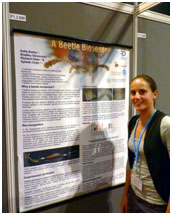A beetle biosensor
 Earlier this year CRC researcher Kelly Bailey from South Australian Research and Development Institute (SARDI), Entomology, travelled to Glasgow, Scotland to attend the 20th World Biosensors Congress. The congress was held in the Scottish Exhibition and Conference Centre in Glasgow from 26 – 29 May 2010 with 1,046 delegates from 52 different countries attending. The congress provided an overview of the current state of biosensor research around the globe.
Earlier this year CRC researcher Kelly Bailey from South Australian Research and Development Institute (SARDI), Entomology, travelled to Glasgow, Scotland to attend the 20th World Biosensors Congress. The congress was held in the Scottish Exhibition and Conference Centre in Glasgow from 26 – 29 May 2010 with 1,046 delegates from 52 different countries attending. The congress provided an overview of the current state of biosensor research around the globe.
At the congress Kelly presented her work on project CRC20081: Biosensor-based detection of grain pests. This was a fantastic opportunity to raise the profile of the CRCNPB, as well as to gain feedback and ideas for the project from a world-wide audience of leading researchers in the field of biosensing. It was also a great opportunity for Kelly to meet potential collaborators who could aid in achieving future project goals.
Kelly presented her work as a poster entitled ’A beetle biosensor’ which was well received by interested delegates. This was a great chance for Kelly to showcase the CRCNPB involvement in this cutting-edge field of biosensing to an international audience of leading researchers. Research presented at the congress was predominantly focused on medical and security applications. No other research focused on insect chemoreception was presented, so it was an opportunity to highlight the CRCNPB as leaders within this niche field; there are many potential biosecurity-related applications for insect chemoreceptor-based biosensors. Delegates were very interested in the potential for using insect chemoreception technology for agricultural applications.
Kelly reported that many researchers focussed on the technicalities of transducing a biosensor signal, rather than investigating how to detect the signal. She expressed that these seminars and discussions were useful as there will be a need to develop a transduction mechanism for the bio-recognition elements being investigated in the CRC20081 project. It was apparent that the approach of the project is novel in that most of the bio-recognition components investigated by other groups were based on the well-established antibody-antigen interactions, DNA binding or affinity peptides. This is in contrast to using the Tribolium olfactory receptors themselves, which being isolated and characterised in the project.
Some of the key points made throughout the congress included a focus on end-user needs as well as elegant biosensor design for economical fabrication. The conference concentrated on technical aspects of biosensor design, including bio-recognition and signal transduction. Stability, selectivity and sensitivity were predominant pre-requisites for the bio-recognition component. A number of speakers indicated some alternative methods to produce stable receptor – mimics for biosensing applications.
Kelly said the conference offered a platform to learn of the research interests of many international biosensor-based groups.
‘It was clear from discussion that varied expertise is required to enable a biosensor platform to become a reality. Groups of particular interest to our project were approached to discuss relevant material and the possibility of future collaboration,’ she said.
Topic areas of the congress included: organism and whole cell-based biosensors; electronic nose technology; and signal transduction technology, all of which are directly related to the grain pest biosensor project. The 2010 conference achieved a record number of abstracts (over 1,000), indicating the increase in research within this field and the importance of developing our capabilities in this area for the future.
A few key concepts of interest, and the people that presented them, included: ion-channel monitoring in free-standing lipid bilayers (Studer, A. Switzerland); peptide receptors based on co-activator amino acid sequences as stable bio-recognition components (Fechner, P. Sweden); the bioluminescence resonance energy transfer (BRET2) technique for signal transduction, as has already been demonstrated with the C. elegans odourant receptor, ODR10 (Dacres, H. Australia); aptamers designed to specific ligands (Le, T. United Kingdom); the generation of antibodies to small and hydrophobic molecules including alkanes via recombinant antibody library technology (Rix, C. United Kingdom); and docking programs to look at odourant binding proteins and their ligands (Munro, L. United Kingdom).
Kelly said, following further characterisation of the insect olfactory system, the knowledge of the biosensing systems into which it might fit will become increasingly applicable.
‘It is always beneficial to foresee what technologies will be the best to investigate for your application, and make the connections to those groups which may be able to assist with expertise in those areas. This conference was extremely useful in that sense,’ she said.
Photo caption: Kelly Bailey displaying her poster at the 20th World Biosensor Congress
TRAVEL DETAILS
BAILEYK
When: May - 2010
Location: Glasgow, Scotland
Summary:
Kelly Bailey raised the profile of the CRCNPB while highlighting work being conducted in biosensor technology at the 20th World Biosensors Congress.

